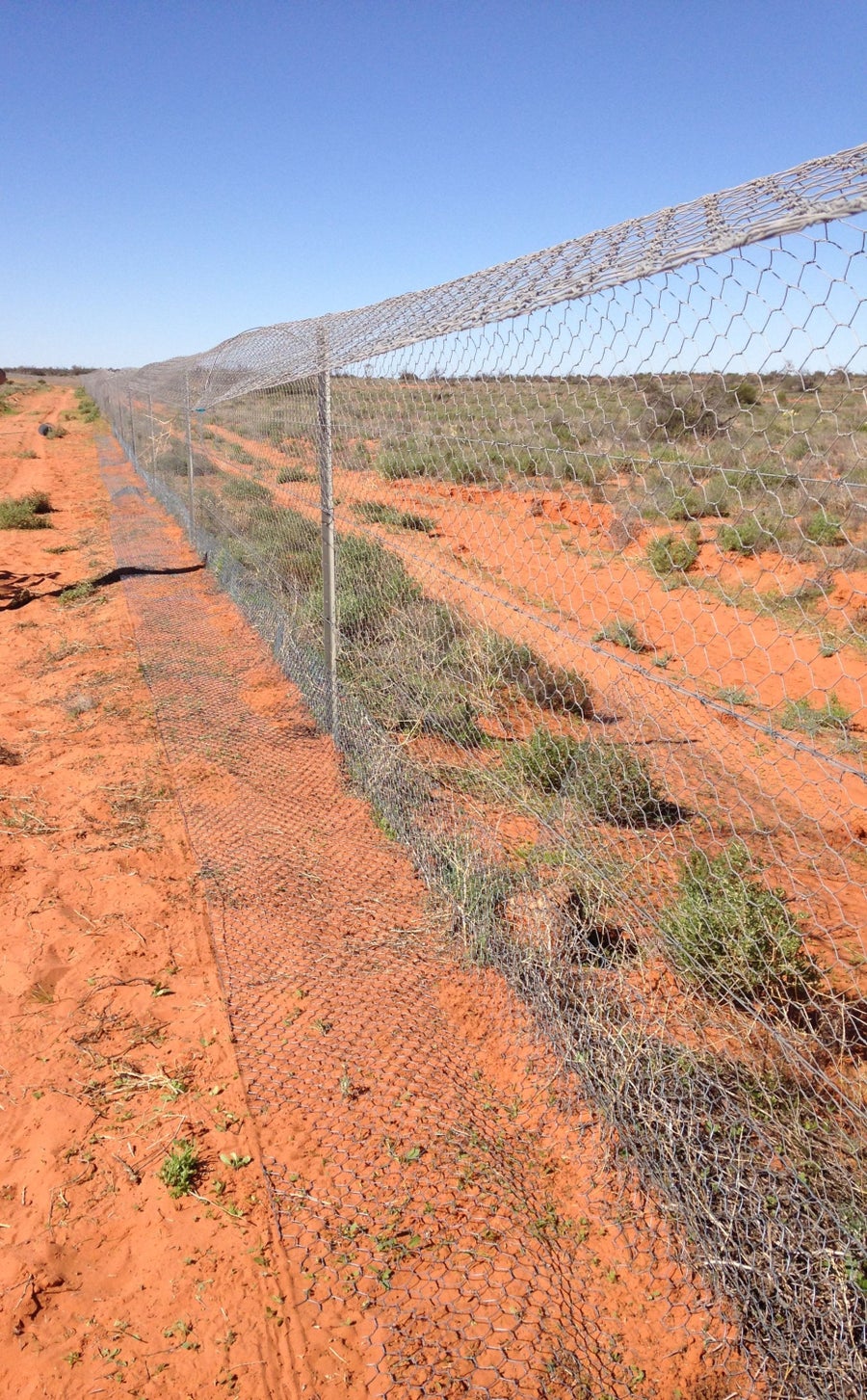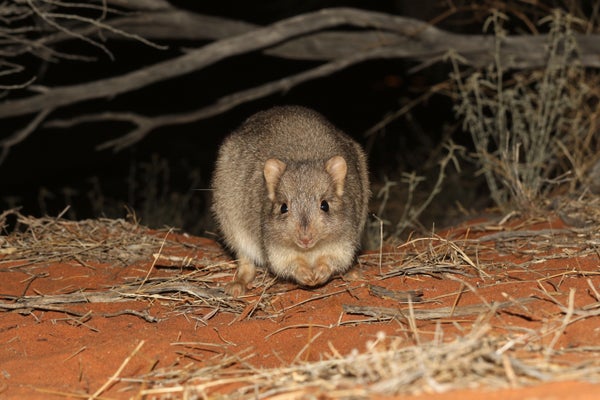In a fenced enclosure amid the red-orange sand and sparse vegetation of remote South Australia, newly released burrowing bettongs—small marsupials that look like a mix between a rat and a miniature kangaroo—used to spend their time blithely lounging around.* They were so naive that they approached humans without hesitation and kept their heads down as they ate. “They showed absolutely zero vigilance behavior,” potentially making them easy meals for feral cats and other predators, says ecologist Rebecca West at the University of New South Wales.
A year later bettongs in the same community made a fast exit when humans—or cats—approached, and monitored their surroundings while eating. The difference? These tiny marsupials had been to predator boot camp.
This tough-love training is part of a new approach that incorporates predator-prey relationships into conservation efforts—including those aimed at rebuilding populations of native Australian mammals decimated by the cats, foxes and rabbits that European settlers introduced. Animals for such efforts come from isolated or captive populations, so they do not grow up learning to recognize predators or predatory behaviors. This so-called prey naivete makes them easy pickings when they are released into the wild, or even into semi-wild enclosures, in the case of the bettongs. Previous studies have found survival rates as low as 11 percent for captive-bred marsupials such as these when they are introduced into the wild.
On supporting science journalism
If you're enjoying this article, consider supporting our award-winning journalism by subscribing. By purchasing a subscription you are helping to ensure the future of impactful stories about the discoveries and ideas shaping our world today.
West and her team are developing the bettong boot camps through a research project called Wild Deserts. It aims to train captive-bred bettongs and other once-abundant Australian mammals to fear predators by exposing them to feral cats in specially designed 20-square-kilometer enclosures, which are themselves within a 104-square-kilometer fenced-off section of Sturt National Park in the arid northwestern corner of New South Wales state.
The effort is not just a matter of Aussie fauna pride. Bettongs and other small animals play important roles in the ecosystem; as they dig their burrows they churn up the soil, redistributing key nutrients. Water and seeds gather in the holes they dig, which helps native plants germinate, and the burrows help provide shelter to other animals.

The fencing that keeps feral cats from wandering into the enclosures where bettongs live as part of the Wild Deserts research project at Sturt National Park in New South Wales, Australia. Credit: Rebecca West
Captive-bred animals are already handicapped for survival in the wild because of their unfamiliarity with the environment and—especially in a place like Australia—because they have evolved over millennia to deal with indigenous predators, not ones imported within a century or two like feral cats. Previous attempts to teach captive-bred animals to avoid predators have been conducted in controlled settings, such as a lab. They involved, for example, exposing the animals to taxidermied cats and simulated attacks. But those simulations do not capture all the behaviors that might be involved with natural predator encounters. That leaves captive-bred animals unprepared, says Doug Armstrong, a conservation biologist at Massey University in New Zealand who chairs the Oceania reintroduction specialist group at the International Union for the Conservation of Nature.
In the wild, by contrast, bettongs and other mammals witness members of their community actually becoming a fox’s dinner—an experience that turns out to be a pretty valuable teaching tool. “You want a bettong to watch its mate get eaten by a cat and think, ‘Oh, geez, cats are scary,’” West says.
That’s where West’s enclosures come in. They provide a way to put the bettongs through these teaching moments in a setting that can be managed—yet is still more natural than a lab or predator-free fenced area. The work is building on a test of the concept described in the Journal of Applied Ecology last year, in which West and her co-researchers showed that captive-bred bettongs can learn survival skills. Two groups of bettongs were placed in separate 26-square-kilometer fenced enclosures. Feral cats were then added to one enclosure but not the second. Cats killed two bettongs in the first enclosure—and the researchers found that their fellows’ behavior became generally warier over the course of a year. The control group’s did not. Subsequent generations of the test group are also avoiding cats, which indicates parents are passing the relevant behaviors along to their offspring.
West is now scaling up from that initial trial to refine the boot camp method. She wants to figure out how long it takes for bettongs exposed to one predator to learn to avoid another in a new environment. She also hopes to determine how many cats, for example, they have to meet up with before they to learn to be suspicious of all cats. And finally, West wants to see if naive bettongs can learn from boot camp graduates.
Armstrong, who is not involved in the boot camp project, cautions that the very nature of such animal reintroductions means grappling with uncertainty. “Just imagine you’ve had a species absent from an area for some time, so you’ve never observed that species in that particular location—and that location has changed in a whole range of ways,” he says.West and her team have already come across some surprises, such as an exploding population of the threatened plains mouse in the partially protected setting of the boot camp enclosures. This could give cats another source of prey, and could alter the landscape with the large burrows and nests the mice build.
Perhaps the biggest key to Wild Deserts’ success—and to bringing back the bettongs and other other once-abundant native species—will be finding the right balance of predator and prey that will allow bettongs to thrive in the wild. That information can be used to guide invasive species eradication programs, including ones aimed at feral cats. Even with bettongs that have learned to avoid cats, a density of about 0.2 cats per square kilometer seems to be optimal for coexistence, West says. That number is at the low end of feral cat estimates in Australia at the moment, but it provides a goal at which cat eradication programs can aim. Finding ways for species to sustainably coexist, including teaching predator avoidance, is essential to bringing back Australia’s native animals, West believes. “That’s the only way,” she says, “if we’re really serious that we want to keep these species on the mainland, and to return them to the wider Australian landscape—and not just tiny pockets.”
*Editor's Note (10/11/18): This sentence was edited after posting to correct the location of the bettong enclosure.
